
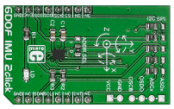
|
6DOF IMU 2 click (Accel, Gyro) Released

6DOF IMU 2 click is a mikroBUS™ add-on board with Bosch's BMI160 low power inertial measurement unit (IMU). The BMI160 is capable of precise acceleration and angular rate (gyroscopic) measurement.
The IMU consists of a state-of-the-art 3-axis, low-g accelerometer, and a low-power 3-axis gyroscope, designed for 6-axis and 9-axis applications. The BTI160 also includes built-in power management unit (PMU) for advanced power management and power-saving modes, as well as allocated FIFO buffer of 1024 bytes for handling external sensor data.
6DOF IMU 2 click communicates with the target MCU through the I2C or SPI bus (user-selectable), with additional functionality provided by the INT pin (for enhanced autonomous motion detection).
The board is designed to use a 3.3 power supply only.
|
2016/09/27 |

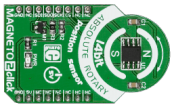
|
Magneto 2 click Released

Magneto 2 click is a mikroBUS™ add-on board with Melexis's MLX90316 monolithic rotary position sensor. Sensing flux density with the IC surface of the MLX90316 allows the click to decode the absolute rotary (angular) position from 0 to 360 degrees.
In combination with the correct library, the magnetic flux density of a small magnet (diametral magnetisation) rotating above the IC can be measured in a non-contacting way.
The sensor enables the design of novel generation of non-contacting rotary position sensors that are frequently required for both automotive and industrial applications.
Magneto 2 click communicates with the target MCU through the mikroBUS™ SPI bus. The board is designed to use a 5V power supply only.
|
2016/09/27 |


|
WiFi6 click Released

WiFi 6 click is a mikroBUS™ add-on board with Bluegiga's WF121-A self-contained Wi-Fi module. With a fully integrated radio and 32-bit microcontroller, this module is ideal for embedded applications.
The module's 2.4GHz band radio is fully compliant with IEEE 802.11b/g/n and offers excellent radio performance. Allows end user applications to be embedded onto the integrated PIC32MX695H, a 32-bit 80MHz microcontroller with 128KB RAM and 512KB Flash memory, for development of lower-cost and smaller sized products. Also integrated on-board is a single power supply.
WiFi 6 click communicates with the target MCU through the mikroBUS™ UART (TX, RX), SPI, or IC2, with additional functionality provided by CTS pin (in place of default mikroBUS™ INT pin); a mikroProg connector allows to update the firmware of the internal PIC32. SPI interface can be accessed by jumpers on the click board. The board is designed to use a 3.3 power supply only.
|
2016/09/27 |

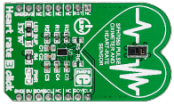
|
Heart Rate 3 click Released

Heart rate 3 click is a mikroBUS add-on board whose functionality is determined by two components: an OSRAM’s SFH7050 pulse oximetry and heart rate monitoring module, and a TI AFE4404 (analong-front-end) IC specialized for bio-sensing.
The SFH7050 multichip package contains 3 LEDs and one photodiode separated with a light barrier to prevent optical crosstalk. When the three LEDs shine through a subject’s finger, some of the light is absorbed by the pulsating blood.
The analog reading from the SFH7050 is forwarded to the AFE chip that is able to derive pulse readings from the intensity of the reflected light.
AFE4404 is highly-configurable and adaptable for different usage scenarios (different lighting conditions or skin tones) making Heart rate 3 click a robust heart rate monitoring solution.
The board communicates with the target MCU through the mikroBUS™ I2C interface, with additional functionality provided by RST, CLK and RDY pins.
Heart rate 3 click works on a 3.3V power supply, but an onboard jumper allows you to set the voltage for driving the SFH7050 LEDs at either 3.3V or 5V.
|
2016/09/27 |


|
DC Motor 3 click Released

DC MOTOR 3 click is a mikroBUS™ add-on board with a Toshiba TB6549FG full-bridge driver for direct current motors. The IC is capable of outputting currents of up to 3.5 A with 30V, making it suitable for high-power motors.
Two pairs of screw terminals are positioned on the top of the board. One is for bringing an external power supply; the other is for connecting a motor.
TB6549FG has four operating modes: clockwise, counter-clockwise, short brake and stop. The operating mode is configured through IN1 and IN2 pins. A separately controlled standby mode is also available.
For safety, the TB6549FG IC incorporates overcurrent protetciont and a thermal shutdown circuit.
The click communicates with the target MCU through the mikroBUS™ PWM pin, with additional functionality provided by IN1, IN2 and SLP pins (in place of default mikroBUS™ AN, RST and CS pins). Designed to use a 3.3 power supply only.
|
2016/09/27 |


|
M-BUS Rf click Released

M-BUS RF click is a mikroBUS™ add-on board with a Telit ME70-169 or ME50-868 RF wireless module. The device is compliant with EN13757 part 4 2013.
The module has specified serial data rates of up to 115.2 Kbps and radio data rates of 2.4, 4.8 and 19.2 kbps. For security, the wireless signal has AES and NRZ encryption. Output power is from 125 mW to 631 mV (28dBm). According to the vendor's data sheet, the module has wireless range of up to 20 km.
Short for Meter-Bus, this protocol was designed for the remote reading of gas or electricity meters, but it's also suitable for alarm systems, illumination installations, heating control and more.
M-BUS RF click communicates with the target MCU through the mikroBUS™ UART interface, with additional functionality provided by RESET, RTS, and CTS pins. The board is designed to use a 3.3 power supply only.
|
2016/09/27 |

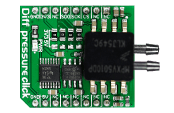
|
Diff pressure click Released

Diff pressure click is a mikroBUS add-on board carrying an NXP MPXV5010DP signal conditioned, temperature compensated and calibrated pressure sensor with two axial ports to accommodate industrial grade tubing. It is designed for comparing two pressure measurements.
The two ports are designated as Pressure side (P1) and Vacuum side (P2). The sensor is designed to operate with a positive differential pressure where P1 > P2. The measurement range is from 0 to 10 kPa. In the temperature range between 0º and 85ºC, the sensor has a maximum error rate of 5.0%.
MPXV5010DP IC has an analog output. The signal passes through the onboard 22-bit ADC before being outputted through the mikroBUS SPI interface (CS, SCK, MISO).
Diff pressure click is designed to use either a 3.3V or a 5V power supply
|
2016/09/27 |

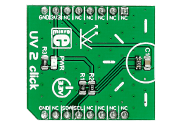
|
UV 2 click Released

UV 2 click is a mikroBUS™ add-on board with a VEML6075 UVA and UVB light sensor. VEML6075 is a CMOS chip that incorporates a photodiode, amplifiers, and analog/digital circuits.
With UV 2 click, Solar ultraviolet light intensity is converted to 16-bit digital values. UVA and UVB are in separate channels. To keep a stable output in changing temperature conditions, the chip has temperature compensation capabilities. This ensures reliable performance under long term UV exposure.
The sensor has a specified UVA sensitivity of 365 nm and UVB sensitivity of 315 nm
The board communicates with the target MCU through the mikroBUS™ I2C interface. Designed to use a 3.3 power supply only.
|
2016/09/27 |

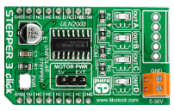
|
Stepper 3 click Released

Stepper 3 click is a mikroBUS™ add-on board for driving unipolar stepper motors with precise controls (individual motor phases can be accessed separately).
The board carries a Texas Instruments ULN2003 High-Current Darlington transistor array for operating the motors.
Motors are connected through a 4-pin male connector on the top of the PCB. They can be driven by the click board's own power supply, or with an external power supply which can be brought through onboard screw terminals (up to 30V).
Stepper 3 click communicates with the target board MCU through mikroBUS™ PWM, AN, RST and CS pins (here used for individual motor phases, marked INA, INB, INC, IND).
The board is designed to use a 5V power supply only.
|
2016/09/27 |


|
Pressure 3 click Released

Pressure 3 click is a mikroBUS add-on board that carries an Infineon DPS310 digital barometric pressure sensor. It has an operating range from 300 to 1200 hPa with a relative accuracy of 0.06 hPa and absolute accuracy of 1 hPa. DPS310 is a fast sensor with typical measurement time of 27.6 ms for standard mode, down to 3.6 ms in low precision mode.
The digital measurements are in 24-bit resolution. Up to 32 results can be stored in a FIFO buffer.
Pressure 3 click has both I2C and SPI outputs. The four interface configuration buttons are soldered to mikroBUS I2C pins by default. The click uses a 3.3V power supply.
|
2016/09/27 |

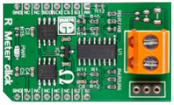
|
R Meter click Released

R Meter click is a mikroBUS add-on board with circuitry for measuring the value of resistors. The board can be used to measure a wide range of resistors (from 0 to 1 Mega Ohm) The design is based on a non-inverting amplifier circuit, with the measured resistor placed in a feedback loop that influences the gain of the amplifier.
The analog output is fed through a 12-bit ADC with the final output going through the mikroBUS SPI interface.
Since the ADC has a limited min-max range (0-2043), R Meter click employs a multiplexer that can adjust the input signal to the amplifier and thus allow the same ADC to measure four different scopes of values (0-1k , 1k-100k, 100k-1M)
The supplied firmware automatically scans the ADC value and switches the multiplexer output based on the resistor in place. The multiplexer interfaces directly with the target board MCU through mikroBUS S1, S2, and S3 pins (in place of default mikroBUS PWM, INT and RST).
Onboard screw terminals are placed to allow the click to be used with multimeter probes.
The board is designed to use a 5V power supply.
|
2016/09/20 |

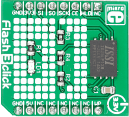
|
Flash 3 click Released

Flash 3 click is a mikroBUS add-on board for adding more Flash Memory to your target board microcontroller. It carries an ISSI IS25LP128 IC with 128 Mbit capacity.
The high-performance Flash chip operates at 50MHz at Normal and 133MHz at Fast Read speeds.
It is specified to standard 100,000 erase/program cycles with more than 20 years of data retention. The data can be erased in sectors or blocks and programmed with 1 to 256 bytes per page.
Each chip has a 128-bit unique ID for each device.
Flash 3 communicates with the target board through the mikroBUS SPI interface with additional functionality provided by HOLD, CE and WP pins. It is designed to use a 3.3V power supply only.
|
2016/08/18 |


|
GSM-GPS click Released

GSM-GPS click is a mikroBUS add-on board with a SIM808 module that combines GSM/GPRS and GPS into a single device. Ideal for remote tracking devices in any shape or form.
The high-performance GSM/GPRS engine works on GSM, EGSM, DSC and PCS frequencies. The GPS has a 1 second TTF (Time To First Fix) from a hot start and 30 seconds from a cold start. Tracking sensitivity is -165 dBm.
The board has two antenna connectors, one for GSM the other for GPS. The bottom side has a SIM card slot and a Micro USB connector for interfacing with a PC.
GSM-GPS click communicates with the target board MCU through mikroBUS UART interface, with additional functionality provided by STAT, PWRKEY, RTS, RS, and CTS. Beside the mikroBUS, the board has additional pins for connecting speakers and a microphone to the GSM engine.
GSM-GPS click uses either a 3.3V or 5V power supply.
|
2016/08/16 |

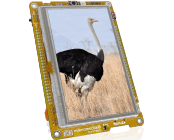
|
mikroMedia Plus for FT90x Released

This board provides a compact high-quality multimedia development platform for FT900 device. It has numerous on-board modules, that allow you to write multimedia applications.
|
2016/08/16 |


|
MCP2542 click (CAN) Released

MCP2542 click is a mikroBUS add-on board with a Microchip CAN FD Transceiver with Wake-Up Pattern. The physical layer is compliant with CAN 2.0 and CAN with Flexible Data Rate (CAN FD). It is designed specifically for high-speed CAN FD applications with communication speeds of up to 8 Mbps. Longer than usual BUS lengths are supported thanks to the improved maximum propagation delay.
The board has a standard RS232 port for CAN communications.
MCP2542 click communicates with the target board MCU through mikroBUS UART interface with an additional StandBy pin (STBY, in place of default mikroBUS AN pin). Two additional pairs of pins on the right edge of the board offer separate UART connection as well as a CAN interface.
The board is designed to use either a 3.3V or 5V power supply.
|
2016/08/16 |


|
SpeakUp 2 click Released

SpeakUp 2 click is a speech recognition click board with a simplified design compared ot the original SpeakUp click. Set it up to recognize up to 100 commands and have the onboard MCU carry them out instantly.
|
2016/08/16 |

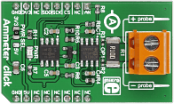
|
Ammeter click Released

Ammeter click is a mikroBUS add-on board with circuitry for measuring electric current (both AC and DC).
Two onboard screw terminals (probe+ and probe-) are bringing in the current, which then passes through a shunt resistor. A voltage proportional to the strength of the current is generated accross the resistor. This voltage passes through an amplifier before it's fed into a 12-bit ADC which then outputs a digital value through the mikroBUS SPI interface.
The firmware processes the digital value to determine the exact amperage between 1mA and 1A for DC current. It's also possible to measure AC current by deriving the value from peak to peak measurements. At the same time, the voltage can be directly monitored through the AN pin.
The board uses either a 3.3V or 5V power supply (it's important not to power the board from the same power source you wish to measure).
|
2016/08/16 |

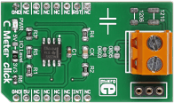
|
C Meter click Released

C Meter click is a mikroBUS add-on board with circuitry for measuring the value of capacitors. The design is based on a NE-555 timer/square-wave generator. The chip is implemented in an astable multivibrator circuit with fixed resistors and adjustable capacitors.
The board has four different-sized plates for placing SMD capacitors (covering standard SMD packaging dimensions) as well as a socket for inserting a thru hole capacitor.
The board outputs a square wave frequency through the INT pin. Depending on the capacitor placed on the board, the value of this frequency changes. The value of a capacitor can be inferred using a simple algorithm (shown in the Libstock code example).
Onboard screw terminals are placed to allow the click to be used with multimeter probes.
C Meter click is designed to use a 5V power supply, but can work with either 3.3V or 5V logic levels.
|
2016/08/16 |

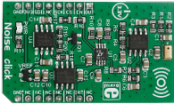
|
Noise click Released

Noise click is a mikroBUS add-on board with noise detecting circuitry. It enables you to set a noise detection threshold for alarm systems, environmental monitoring or data logging. When the volume of ambient sound reaches the set threshold, an interrupt is triggered.
The most important parts of the circuit are the microphone, an RMS-to-DC converter, two dual rail-to-rail Input/Output 10 MHz operational amplifiers, and a 12-bit digital-to-analog converter (DAC).
The 12-bit DAC provides the reference voltage - the noise threshold - for the comparator. You set the exact level through the SPI interface. The threshold should be configured through trial and error (4096 discrete values to select from).
Beside SPI, EN and OUT pins provide additional functionality.
The board works on a 3.3V power supply.
|
2016/08/16 |


|
Proteus VSM for ARM Cortex-M0 Released

Simulation of Cortex-M0 series microcontrollers, including variants from NXP.
|
2016/08/11 |

|

